|
The Woodland Education Centre |
|
|
The Woodland Education Centre |
|
Introduction
| The Heathland Restoration
Project is a habitat management experiment which has been running since 1995. The aim
of the experiment is to restore a lowland heath habitat on the project site, while also
examining the effects of different management techniques on the restoration process. The
project is based on a 2 hectare site at the Woodland Education Centre in Offwell, near
Honiton, East Devon, SW England. The project site was formerly wooded with conifers and Sweet Chestnut, with an understorey of rhododendron. The conifers were non-native and were planted by the Forestry Commission in the 1960's. This woodland was completely cleared in 1993. The site was subsequently divided into nine sections and allowed to regenerate naturally.
Different management techniques have been used on the different sections to test their effects on lowland heath restoration. The management regimes began in 1995/1996 and are on-going. Vegetation changes on the Heathland Restoration Project site have been monitored from 1996 onwards. Annual plant ecological survey reports for the years 1996 - 2001 document the gradual changes in plant cover taking place in each of the differently managed sections and across the site as a whole. Background to the Project |
|||||||||||||||
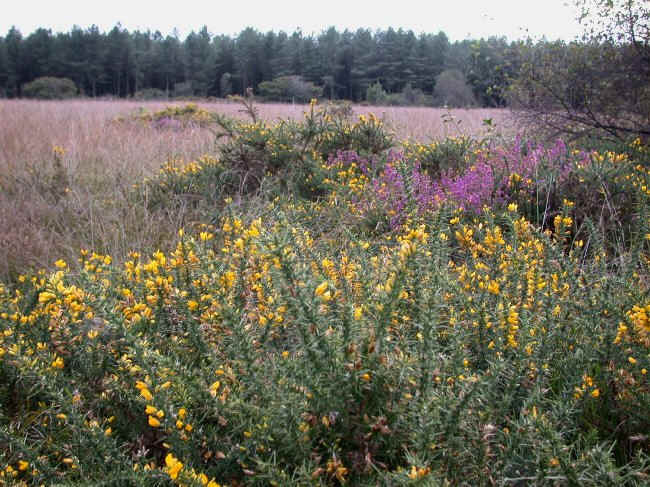 |
Heaths are habitats dominated
by dwarf shrubs, with heathers and gorse usually forming a major part of the plant
community (left). In Britain, lowland heath is defined as heathland which occurs at
altitudes of less than 300 metres. Centuries ago, much of East Devon would have been covered in lowland heath, particularly on the tops of the hills. The scattered patches of heath remaining in East Devon today are the isolated remnants of what must once have been large, tracts of heathland. |
 |
The Heathland Restoration
Project site is within the Woodland Education Centre. The Centre is a Forestry Commission
site, created and managed by the Offwell Woodland & Wildlife Trust. The 50 acre Centre is dedicated to conservation and practical environmental education for all ages. Since 1986, it has been restored from a virtually worthless rhododendron jungle, to an area containing a wide variety of different native habitats. (Map here) |
| The project site is
surrounded by woodland. On old maps of the region, this area is marked as 'The Husk'. This
implies that it was regarded as fairly worthless land from an agricultural point of view
and was likely to have been left as an area of rough, uncultivated commons. The site has the sandy, acid, nutrient-poor soil, characteristic of lowland heath. This, together with its cool, moist climate mean that the area has almost certainly existed as a heath in past centuries. This is an important point, because it means that the site is naturally inclined towards becoming a lowland heath habitat, without requiring extensive remediation. |
| The Heathland Restoration
Project site was cleared of a failed conifer crop, mixed with Sweet Chestnut and a
rhododendron understorey (inset right) in 1993. It was then left to regenerate naturally. The site was divided into nine sections and different management techniques, designed to halt the succession process and prevent the site from developing into a scrub woodland, were assigned to various sections. |
| While there were no signs
of Heather at all on the project site prior to clearance, it has grown naturally
on the cleared site without the need for any kind of seeding with material brought in
from other heathland areas. The nearest area of lowland heath habitat which could theoretically provide a source of wind-borne heather seed is Gittisham Common (left). This is slightly less than 3 miles away as the crow flies, to the south west of the Woodland Education Centre. |
| The elevation profile of the land between the two areas shows intervening high ground, along with several valleys. |
| Gittisham
Common is at an altitude of approximately. 800 feet, while the Heathland Restoration
Project site is at roughly 520 feet elevation. Although the prevailing winds in this area of Britain are south westerly, the Woodland Education Centre and the project site are in a south facing valley, largely sheltered from the prevailing winds. This, together with the hilly topography between the two sites, makes it unlikely that much heather seed is transported from Gittisham to the project site in this way. |
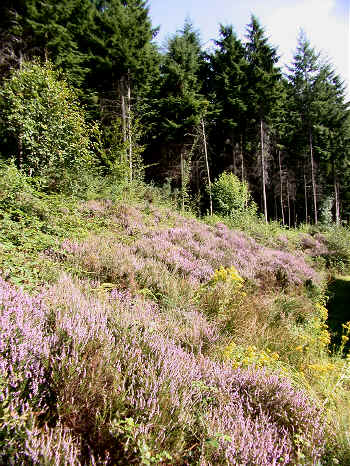 |
It is probable that much of
the Woodland Education Centre has been lowland heath in the past. Isolated Heather plants
can be seen springing up alongside tracks and rides in several areas around the Centre and
in some places (left) quite large stands of Heather have developed naturally. The Centre is within the parish of Offwell. The parish (with a total area of approximately 800 hectares) is reputed to have contained around 200 hectares of lowland heath prior to 1936. All of this original heathland has now been lost to agriculture, forestry and natural succession to woodland. All that remains is the lowland heath being restored on the Heathland Restoration Project site Heathers produce long-lived seeds capable of germinating many decades after deposition. The natural regeneration of Heather on the project site indicates that the site has supported heathland plant species in the past, leaving a residual seed bank in the soil. |
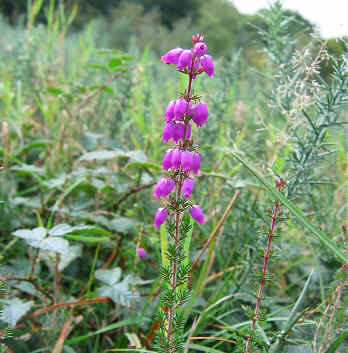 |
Natural regeneration of
lowland heath on the project site may be aided by another very important factor. Heathers,
which are one of the main dwarf shrubs making up a heath plant community, are members of
the plant family 'Ericaceae'. The roots of ericaceous plants such as Bell Heather (left) and Heather, form very specific mycorrhizal associations with certain soil fungi, which are peculiar to the Ericaceae alone. These mycorrhizae confer benefits on both the plants and the fungi and extensive underground networks may be formed. Much of the ability of heathers to grow well on nutrient-poor soils is undoubtedly due to the extra nutrients which they derive from their fungal partners through the mycorrhizae. The mycorrhizae also increase plant resistance to low pH. More on mycorrhizae here |
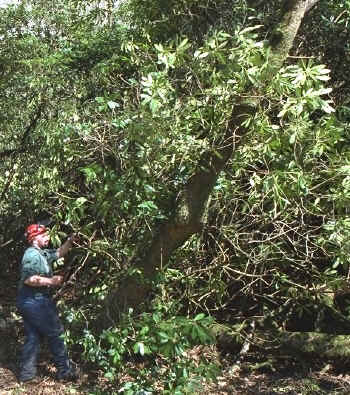 |
Rhododendron (left) also belongs to the
Ericaceae, forming ericaceous mycorrhizal associations in the soil. In 1986, most of the
Centre was covered in non-native rhododendron, much of which has since been removed to
restore native habitats. The success of the rhododendron in colonizing and taking over the
area originally may have been due in no small measure to the presence of ericoid
mycorrhizal fungi in the soil from former heathland habitats existing on the site. It has already been noted that the Heathland Restoration Project site was covered in a rhododendron understorey prior to clearance. This means that ericoid mycorrhizal fungi are present in the soil of the project site, derived both from past heaths and recent rhododendron infestation. These are now presumably available to assist heathers and other ericaceous plants, such as bilberry, to successfully recolonize the area. |
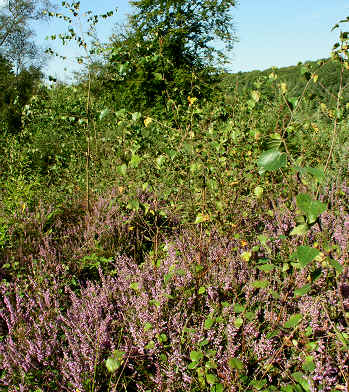 |
The project site is naturally inclined towards becoming a
heathland habitat. One or more of the different management regimes being applied to the
different sections will have the effect of promoting heath species at the expense of
others and heath communities will gradually establish on these sections. Habitat restoration is a long term process which does not happen overnight. This is therefore a long term experiment which will run for many years. The outcome will be a thorough understanding of the progressive effects of specific management methods on this area. These insights should allow similar methods to be employed on comparable sites within the region, with broadly similar results. |
Continue to >> Site Description
Ecological Surveys 96 - 98 |